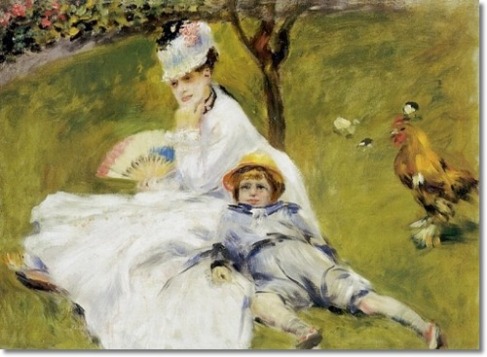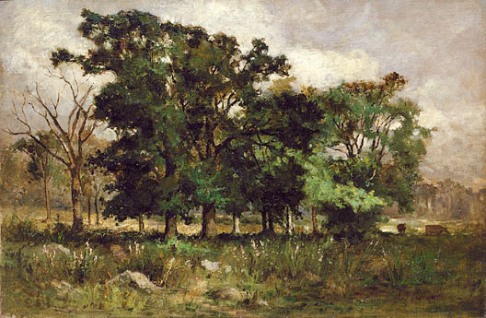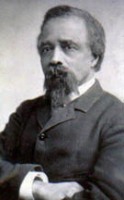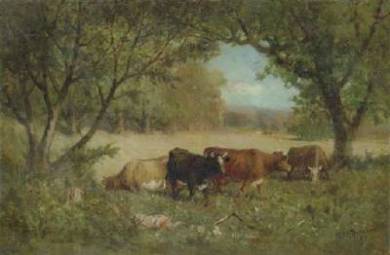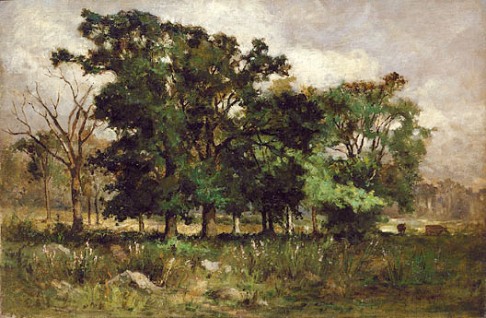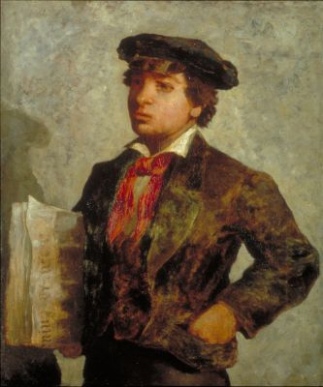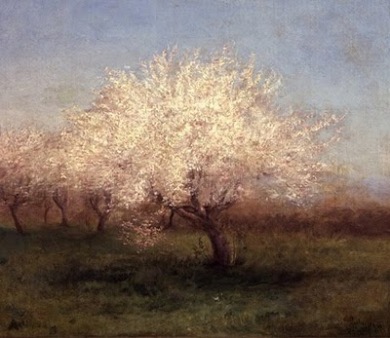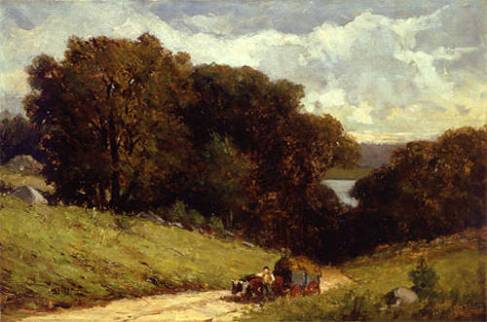

Movement, Style, School or Type of Art:
American Romanticism
Date and Place of Birth:
1821, Fayette, New York
Early Life:
Robert Scott Duncanson was among the few African Americans who
established a professional career as an artist during the nineteenth century. He was born in Seneca County, New York to a Scottish-Canadian white father and African American mother. He grew up in Canada with his father, while his mother lived in Mount Pleasant, Ohio. In 1841, he moved to his mother’s home, which was not far from Cincinnati, then a burgeoning metropolis. He eventually settled in that “Athens of the West.”
Career:
Duncanson studied art on his own, copying the masters he admired. He was principally influenced by the landscapist Thomas Cole and the Hudson River School. By 1842, he exhibited his portraits and received many commission as a result. He also participated that year in an exhibition sponsored by the Society for the Promotion of Useful Knowledge, but his family was barred from attendance because of their African American ethnicity.
Duncanson continued to thrive in Cincinnati as he became a much appreciated landscape painter with his views of the Ohio River Valley. In 1851, winemaker Nicholas Longworth (1783-1863) commissioned eight enormous murals from the artist to decorate the foyer of his Palladian style villa, Belmont. Today Longworth’s home is the Taft Museum of Art.
Mature Work:
In 1853, Duncanson was asked to illustrate Harriet Beecher Stowe’s Uncle Tom’s Cabin and then, financed by the Freeman’s Aid Society and the Anti-Slave League, Duncanson departed for a tour of Europe where he discovered the French landscapist Claude Lorrain (1600-1682) and the craze for Orientalism.
Back in Cincinnati in 1854, Duncanson spent the next four years painting and collaborating with the African American photographer and abolitionist activist James Presley Ball (1825-1904) by retouching and painting over Ball’s photographs. Together they created the 600-foot long mural entitled the Mammouth Pictorial Tour of the United States Comprising Views of the African Slave Trade (1855).
When the Civil War broke out, Duncanson moved to Montreal and, in 1865, to the United Kingdom, spending most of his time in England and Scotland. He returned to Cincinnati during the winter of 1866-67 and remained there until his death. He died in Detroit at the age of 51 while preparing an exhibition.
Best Known For:
Duncanson is best known for his shimmering, dreamy landscapes that feature enormous vistas, most notably his two paintings entitled Vale of Kashmir, 1864 and 1870.
Important Works:
. Uncle Tom and Little Eva, 1853, The Detroit Institute of Arts
. Entryway murals, 1855, Taft Museum of Art, Cincinnati
. The Rainbow, 1859, Museum of African Art
. Fall of Minnehaha, 1862, Museum of African Art
. Vale of Kashmir, 1864, Museum of African Art
. Vale of Kashmir, 1870, Courtesy of Michael Rosenfeld Gallery, LLC, New York
Date and Place of Death:
December 21, 1872, Detroit, Michigan
Sources:
Driskell, David C. Two Centuries of Black American Art.
Los Angeles and New York: Los Angeles County Museum and Alfred A. Knopf, 1976.
Sims, Lowery Stokes. African American Art: 200 Years.
New York: Michael Rosenfeld Gallery, 2008.
Ketner II, Joseph D. The Emergence of an African American Artist: Robert S. Duncanson, 1821-1872.
Columbia: University of Missouri Press, 1993.
Although Hudson River style landscape painting is most associated with Robert Duncanson, his floral still lifes first brought him recognition. He is also thought to be the first black painter and muralist in America to earn his living by painting and to become internationally known.





http://www.pbs.org/wnet/aaworld/arts/duncanson.html
arthistory.about.com/od/names_dd/a/duncanson_robert_s.html
Artworks
- Trial of Shakespeare,1843 (Douglass Settlement House, Toledo, Ohio )
- Roses Fancy Still Life, 1843 (National Museum of American Art, Smithsonian Institution, Washington, D.C. )
- Drunkard’s Plight, 1845 (Detroit Institute of Arts )
- At the Foot of the Cross, 1846 (Detroit Institute of Arts )
- Cliff Mine, Lake Superior, 1848 (F. Ward Paine Jr.)
- Mayan Ruins, Yucatan, 1848 (Dayton Art Institute )
- The Belmont Murals, 1850–1852 ((Panels) Taft Museum, Cincinnati, Ohio )
- View of Cincinnati, Ohio From Covington, Kentucky, 1851 (Cincinnati Historical Society)
- The Garden of Eden (after Cole), 1852 (High Museum of Art, Atlanta, Georgia )
- Dream of Arcadia (after Cole), 1852 (Private Collection, New York)
- Uncle Tom and Little Eva, 1853 (Detroit Institute of Arts )
- Italianate Landscape, 1855 (California African American Museum, Los Angeles, California )
- Robbing the Eagle’s Nest, 1856, (National Museum of African American History and Culture)
- The Rainbow, 1859 (National Museum of American Art, Smithsonian Institution, Washington, D.C. )
- Land of Lotus Eaters, 1861 (Collection of His Royal Majesty, the King of Sweden )
- Vale of Kashmir, 1863 (Private Collection, Detroit)
- A Dream of Italy, 1865 (Birmingham Museum of Art, Birmingham, Alabama)
- Cottate Opposite Pass at Ben Lomond, 1866 (Museum of Art, North Carolina Central University, purchase)
- Loch Long, Scotland, 1867 (National Museum of American Art, Smithsonian Institution, Washington, D.C. )
- Dog’s Head Scotland, 1870 (Museum of Fine Arts, Boston )
- Landscape, 1870 (Private Collection, Philadelphia, Pennsylvania )
-
Vulture and Its Prey (1844)
-
Portrait of Freeman Cary (c. 1856)
-
-
On the St. Annes, East Canada (1863-65)
-
Waterfall on Mont-Morency(1864)
-
-
-
Vesuvius and Pompeii (1870)
-
Ellen’s Isle, Loch Katrine(1871)
-
“Blue hole”, Petite rivière Miami (affluent de l’Ohio), (1851)
Exhibitions
1842 Annual Exhibition of Paintings and Statuary, Western Art Union, Cincinnati, OH
1843 Annual Exhibition of Paintings and Statuary, Western Art union, Cincinnati, OH
1864 Art Association of Montreal, Montreal, Canada
1865 Art Association of Montreal, Canada Dublin Exhibition, Ireland
1871 Western Art Gallery, Detroit, MI
1943 Balmoral Castle, Scotland, Museum of Modern Art, NY
1953 Denver Art Museum, Denver, CO
1955 Cincinnati Art Museum, Cincinnati, OH
1961 Indianapolis Museum of Art Indianapolis, IN
1967 Howard University Gallery of Art, Washington, D.C.
1970 La Jolla Museum of Contemporary Art, La Jolla, CA
1971 Bowdoin College, Museum of Contemporary Art, Brunswick, ME
1972 Cincinnati Art Museum, Cincinnati, OH
1972 Museum of Fine Arts, Boston, Boston, MA
1976 Los Angeles County Museum of Art, Los Angeles, CA
1979 Detroit Institute of Arts, Detroit, MI
1983 National Museum of American Art, Washington, D.C.
1992 National Museum of American Art, Washington, D.C.
1996 Washington University, St. Louis, MO
1999 To Conserve a Legacy- American Art from History, Black Colleges and Universities,” Studio Museum in Harlem, NY
2003 Then and Now: Selection of 19-20th Century Art by African American Artists, Detroit Institute of Arts, Detroit, MI
2009 Cincinnati Art Museum, Cincinnati, OH
See also
External links
Notes
- ^ Kahn, Eve M. (15 July 2011). “ANTIQUES; Condemning Slavery With a Paintbrush”. The New York Times: p. 24.
- ^ Public Broadcasting System, Pre-Civil War: Robert Scott Duncanson. http://pbs.org/wnet/aaworld/arts/duncanson/html
- ^ Bearden, Romare, and Harry Henderson. Black Master of American Art. New York: Zenith Books, 1972
- ^ Lifting the Veil: The Emergence of the African American Artist. St. Louis: Sayers Printing, 1995
- ^ a b c d e Lifting the Veil, 1995
- ^ a b c d Bearden, 1972
- ^ a b c d e f g h i Ketner, Joseph D. The Emergence of the African-American Artist: Robert S. Duncanson, 1821–1872. Columbia: University of Missouri Press, 1993. ISBN 0-8262-0880-0
- ^ “Lifting the Veil” 1995.
- ^ Public Broadcasting System
- ^ Willis, Deborah. J.P. Ball, Daguerrean and Studio Photographer. New York: Garland, 1993. ISBN 0-8153-0716-0.
- ^ Pringle, Allan. “Robert S. Duncanson in Montreal, 1863–1865.” American Art Journal 17, no. 4 (1985)
- ^ Pringle, 1985
- ^ Boyd, Herb. Images and memories Galore at Studio Museum in Harlem. New York Amsterdam News 90, no.21 (1999)
- ^ Powell, Richard J. “Seeing and Thinking About the unexpected in American Art.” American Visions 14, no 1 (1999)
- ^ Powell, 1999
- ^ Bill Hodges Gallery.Robert Duncanson 1821–1872: Landscape, 1870. New York: Bill Hodges Gallery & Merton D. Simpson Gallery, Inc., 2003
- ^ Kleeblatt, Norman L. “Master Narratives/Minority Artists.” Art Journal 57, no.3 (1998) Some information from wikepidia
